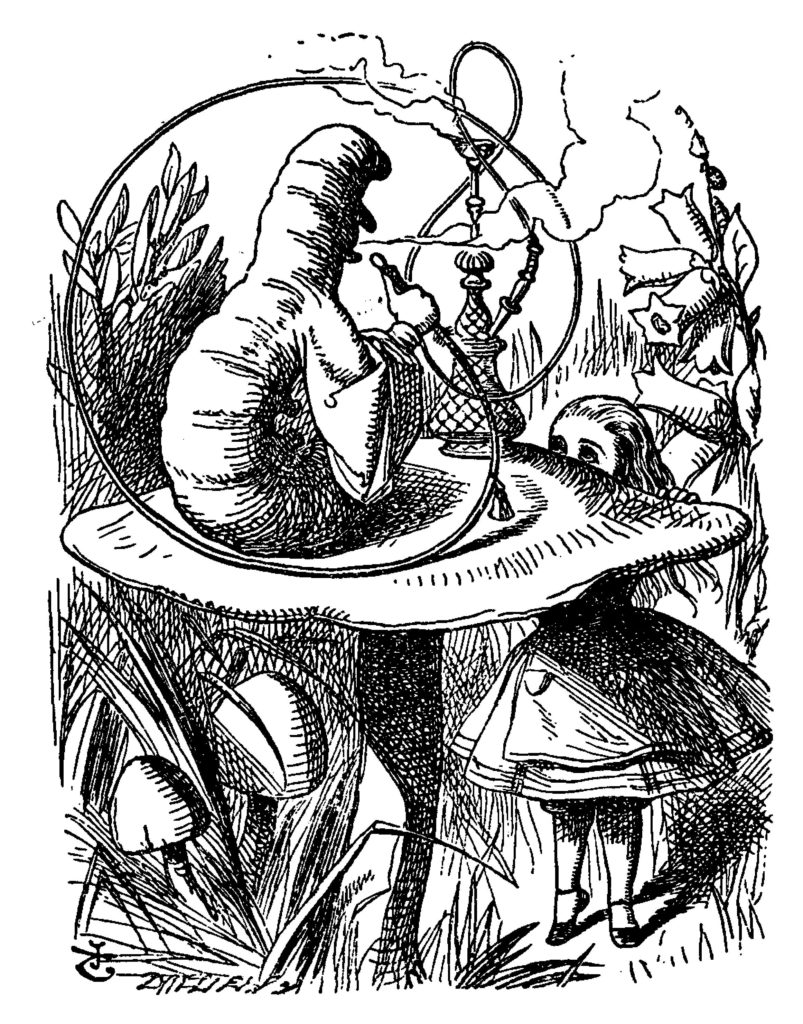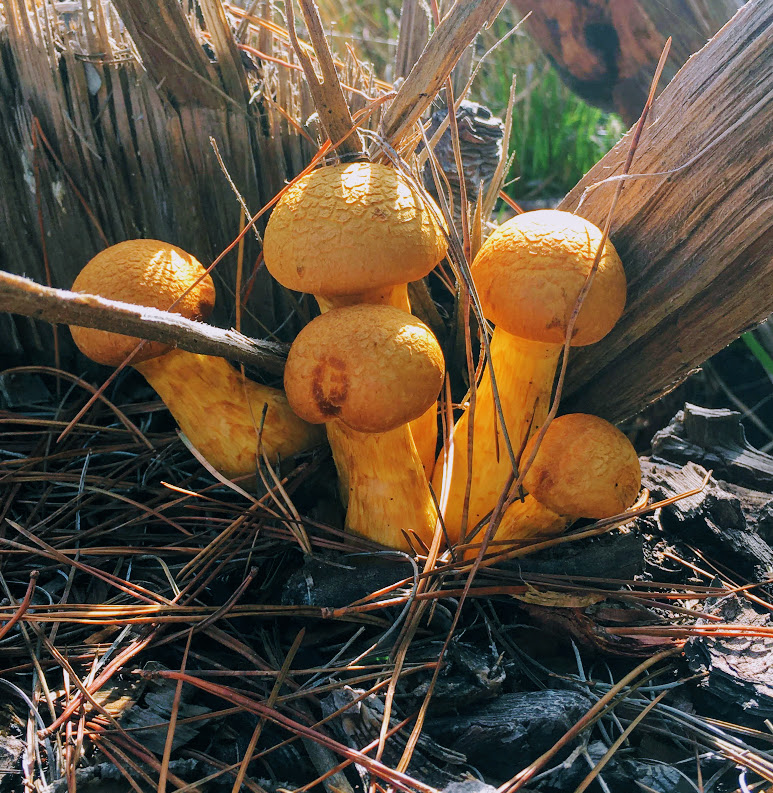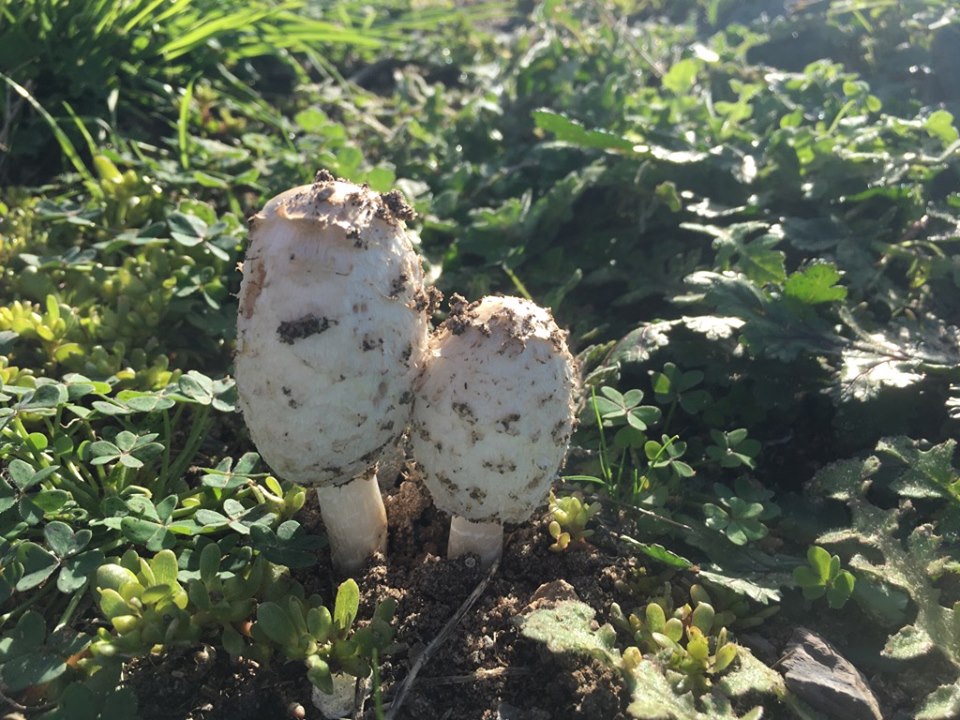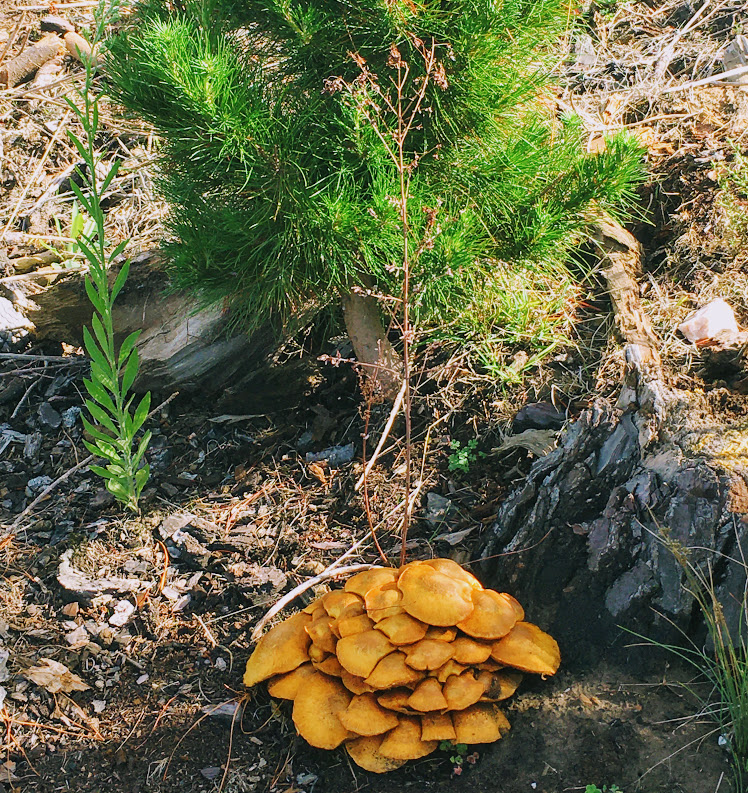
Caterpillar: … One side will make you grow taller…
Alice: One side of what?
Caterpillar: …and the other side will make you grow shorter.
Alice: The other side of what?
Caterpillar: The mushroom, of course!
~Lewis Carroll, Alice in Wonderland
Autumn in the northern hemisphere involves a wealth of deciduous foliage that turns orange, gold, rust or russet before falling to the ground. Within weeks, the trees are bare and the earth has been denuded of all colour bar grey. In the southern hemisphere, as blossom peaks forth in Europe, it is autumn now. European trees add glorious colour to the landscape in the Adelaide hills, but here by the sea, the trees are mostly natives, and the foliage is largely khaki. Any colour comes from the flowering shrubs: a flash of lemon yellow mimosa or a burst of ruby red bottlebrush, a dash of raspberry pink callistemon, or a sprinkling of cherry red grevillea. There has been a wonderful abundance of rain, so the hills, burnt to dust by the summer sun, are now a lush green. And the countryside is awash with wild mushrooms.
There was a magic to mushrooms, long before I knew about the hallucinogenic variety. Alice meets a talking caterpillar who smokes a hookah and philosophizes from his perch on a broad mushroom; fairy rings of toadstools are entrenched in folklore, as a place where fairies, elves and pixies gather to dance. Children are warned to stay outside such rings, as trespassers may be taken prisoner by the fairies and not returned for years.
Well, we haven’t seen any fairies, but over the last couple of weeks, wherever we venture, we have found mushrooms: in the pine forests along the Hay Flat Road; beneath the Tasmanian blue gums by Waterfall Creek; in the middle of a paddock, or under the native grasses in our neighbour’s garden.
Our kind multiplies:
We shall by morning
Inherit the earth.
Our foot’s in the door.
~ Sylvia Plath

I am no expert on which ones are edible and which are best avoided, but I have since scoured the library for information, to see if I can identify the ones we’ve found. Shaggy parasol mushrooms lurk in the garden. Cèpe des pins, a variety of bolete with their sponge-like pores, love the pine forests. On an open hilltop, several different sorts grow in clusters from stumps of eucalyptus or pine. Are they sulphur tufts or giant gold caps or something else entirely? Then there are the toadstools, shimmering brightly in the undergrowth, their red caps like traffic lights, warning ‘stop’ and ‘do not eat me,’ yet looking so pretty among the pine needles.
Last weekend, as we strolled through the forest above Ingalla Falls, we came across a family who had gleefully gathered baskets full of saffron milk caps, and were heading home to cook them up for breakfast. As we paused to admire their efforts, they assured us that there were plenty more to be found. We said goodbye and headed off with ‘great speedy speed‘ in search of lunch.
As we scoured the forest floor for hidden treasure, I trawled the internet to be certain we were on the right track. Sure enough, we had hit the jackpot and our booty matched the description: the cap was an orange/ peachy colour, concave in the centre, with edges that tended to roll inwards. Many had grown up to 20cm in diameter. The gills were a lighter orange, dusted with an orange (saffron) powder that stained our fingers. Easily bruised, the damaged area quickly turned green, as copper does, which initially made us highly suspicious about their edibility. Yet this proved to be a distinguishing feature.
Lactarius deliciosus is native to the southern Pyrenees, where it grows happily beneath Mediterranean pines. These curvaceous and attractive mushrooms have been introduced to Australia and will grow happily in the shade of pine plantations. They also looked like just the kind of mushroom on which the caterpillar would have sat to converse with Alice.

Scooping them up eagerly, we carried them back to the car in an open umbrella, for want of the more traditional wicker basket. Sautéed in butter with lashings of garlic, seasoned with salt and pepper and served on toast, ‘et voila!’ we had a simple, but tasty lunch. What could be more delicious? And what to do with the rest? A mushroom risotto, perhaps? Or gently fried in olive oil and garlic, then stirred into pasta with a generous sprinkling of parsley. And all the joy of a free meal gleaned from the woods.
Over the years, we have made the acquaintance of a variety of mushrooms, both wild and tame. Long ago, cycling through the Loire Valley in France, we came across limestone caves where a mushroom farm – Le Champignonniere Du Saut Aux Loups – had become a tourist attraction. Not a journey for the claustrophobic, we followed our guide through tunnels beneath the cliffs, and into huge caverns where clean white mushrooms emerged from peat-coloured soil in vast tubs. Sadly, we were too early to be fed – ‘pas de cuisine jusqu’à midi’ – but we did learn a lot about the cultivation of mushrooms, information I have long since forgotten, but much appreciated at the time.
Some years later, when the kids were small, weekends were spent wandering through the woods at the end of our village, on the outskirts of Prague. In October, we would spot local foragers between the trees, who would descend to gather mushrooms. It was virutally a national sport.
(FYI: mycophagy means the consumption of mushrooms. I’m hoping this will reappear as a crossword clue while I can still spell it).
Back to my Czech foragers, who were now glaring at us suspiciously, obviously afraid we would steal their edible treasure. In the Czech Republic, there is a joke that all mushrooms are edible, but some only once. For this reason alone, we could have assured them – if we had spoken more than five words of Czech – that we were absolutely no threat at all. If they weren’t Swiss Browns in a Sainsbury’s punnet, we were not about to risk our lives.

We were delighted to find friends with a working knowledge of mushrooms, when we visited them at their beautiful summer cottage on a lake north-east of Helsinki. One afternoon, we followed the girls into the woods in search of chanterelles. These experienced young mushroom hunters seemed to have an instinct for where the mushrooms snuggled among the birch tree roots. Pretty, trumpet-shaped fungi, soft yellow in colour, with a light, peppery flavour, chanterelles are common in the southern and central parts of Finland. While there are no doubt more sophisticated ways to cook them, they are quite perfect simply sautéed in butter.
Then, by some strange twist of coincidence, my physio’s opening gambit yesterday was to launch into tales of gleaning mushrooms in the Adelaide Hills. While I have no idea what they look like, I can now repeat lovely names like honey fungus, laccaria, amanita rubescens and the more familiar porcini.
So, next autumn, I plan to be prepared with a wicker basket and someone with a good understanding of fungi and which ones can be safely eaten. And perhaps we will even come across a fairy or two…
